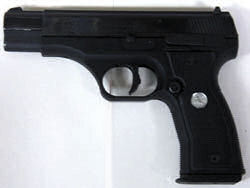Colt 2000
| All American 2000 | |
|---|---|
 Polymer framed version of the Colt All American 2000 pistol | |
| Type | Semi-automatic pistol |
| Place of origin | United States |
| Production history | |
| Designer | Reed Knight, Eugene Stoner |
| Designed | 1992 |
| Manufacturer | Colt |
| Produced | 1992–1994 |
| No. built | ~20,000 |
| Variants | Polymer Frame, Aluminum Frame |
| Specifications | |
| Mass | Polymer version 29 oz. Aluminum version 32 oz. |
| Length | 190 mm (7.5 in) |
| Cartridge | 9×19mm Parabellum |
| Feed system | 15-round Detachable box magazine |
| Sights | Fixed, 3-dot |
The Colt 2000 or All American 2000 is a polymer or aluminum-alloy framed, locked-breech, rotating barrel, semiautomatic, 9 mm handgun with a magazine capacity of 15 rounds manufactured by Colt.
Designed by C. Reed Knight and Eugene Stoner, it was hoped by Colt that this pistol would recapture their stake in the police market as departments across the United States switched from double-action revolvers to semiautomatic pistols.[1][2][3][4] However, the pistol was plagued with reports of inaccuracy and unreliability, and is regarded as an embarrassing failure.[5][6]
History
[edit]The Colt All American 2000 was introduced at the 1990 Shooting Hunting and Outdoor Trade Show (SHOT Show). It had been a joint venture between Reed Knight and Eugene Stoner of Knight's Armament over a period of several years. Once the design was handed off to Colt, the two designers had little input regarding the final design.[7]
C. Reed Knight specified that the pistol should have a 6-pound trigger pull. Colt increased this to 12 pounds and extended the barrel and length of the grip frame.[7] The Colt 2000 was made from parts produced by an outside vendor and assembled in the company's West Hartford facility.
Despite the innovations and bearing the Colt name, the pistol was plagued with reports of inaccuracy and unreliability, and suffered from the poor publicity of having to be recalled in 1993 due to a safety recall.[8] The massive product launch failed and production of the All American 2000 ended in 1994. Colt's President Ron Whitaker stated that sales volume was not sufficient for production to remain economical.[9]
Colt historian, Rick Sapp, has called the pistol "one of the most embarrassing failures in the company's history."[10] Massad Ayoob was particularly critical of the design calling it "sad and ugly with pathetic accuracy".[11]
Design
[edit]The Colt 2000's internal workings were based on older firearms designs from the early twentieth century.[12] The rotating barrel, for example, was based on that of the Steyr 1912 and the trigger and sear mechanisms were based on the Le_Français_(pistol) produced by the French Manufacture d'Armes et des Cycles de Saint-Etienne since 1914.[12] These features allow the barrel and slide to work as a unit moving to the rear until the barrel lug rotates into the cam-block and stops. The barrel lugs then align to allow the slide to continue its travel to the rear and extraction and ejection of the spent round occurs. The pistol breaks down into seven major parts for disassembly.[13] Unlike most other polymer-framed handguns, the All-American 2000 had removable grip panels.[14]
An aluminum framed version of the pistol with wooden grips was made in addition to the polymer framed version and both are sought after by collectors of Colt Firearms because of the low numbers produced during their short production run.[13]
See also
[edit]References
[edit]- ^ Farrell, Scott (1992). "Where the action is: the double-action-only pistol round-up". Shooting Industry. Archived from the original on 2007-11-13. Retrieved 2007-02-25.
- ^ "The legend lives on - Colt files for bankruptcy". Shooting Industry. 1992. Archived from the original on 2015-09-24. Retrieved 2007-02-26.
- ^ Taffin, John (1993). "The spring handgun review!". Shooting Industry. Archived from the original on 2015-09-24. Retrieved 2007-02-26.
the 9mm of choice now offered by Colt's is the All American 2000.
- ^ "Wholesalers show reveals market direction - Industry News". Shooting Industry. 1993. Archived from the original on 2015-09-24. Retrieved 2007-02-26.
Colt's manufacturing gave a first look at their new compact version of the All American 2000, a gun which, if priced competitively, may have a significant impact on the handgun market.
- ^ Sapp, Rick (2007). Standard Catalog of Colt Firearms. F+W Media, Inc. p. 171. ISBN 0896895343.
- ^ Beekman, Christian (June 17, 2015). "Colt Defense's Bankruptcy Marks A Changing Small Arms Industry". Task & Purpose. Archived from the original on November 27, 2016. Retrieved November 26, 2016.
- ^ a b Lewis, Jack (2004). "Colt's All American 2000". The Gun Digest Book of Assault Weapons. Iola, Wisconsin: Krause Publications Craft. pp. 49–50. ISBN 0-87349-658-2.[permanent dead link]
- ^ Hopkins, Cameron (2001). "Kimber Ultra Ten II". American Handgunner. Archived from the original on 2015-09-24. Retrieved 2007-02-26.
Some have been design breakthroughs,...while others have been utterly uninspiring, like the defunct Colt All-American 2000.
- ^ "Colt's renames Cadet pistol - Colt's Manufacturing Company Inc.'s Colt .22 Single Action pistol". Shooting Industry. 1994. Archived from the original on 2015-09-24. Retrieved 2007-02-25.
The gun was selling at the rate of 10-12,000 units per year, and for a manufacturer of our size, with 900 employees, it was not enough
- ^ Sapp, Rick (2007). Standard Catalog of Colt Firearms. Iola, Wisconsin: F+W Media, Inc. p. 171. ISBN 0-89689-534-3.[permanent dead link]
- ^ Ayoob, Massad (2007). The Gun Digest Book of Combat Handgunnery. Iola, Wisconsib: Gun Digest Books. p. 27. ISBN 1-4402-2654-7.[permanent dead link]
- ^ a b Thompson, Leroy; Smeets, René (1993). Great Combat Handguns. London: Arms & Armour. pp. 97–100. ISBN 1-85409-168-9.
- ^ a b Hartink, A.E. (2002). The Complete Encyclopedia of Pistols and Revolvers. Edison, New Jersey: Chartwell Books, Inc. pp. 87–88. ISBN 978-0-7858-1519-8.
- ^ O'Brien, Bill (1994). "High-Tech Handguns...Futuristic Firepower!". Vol. 38, no. 1. Guns & Ammo Magazine. pp. 32–39.
